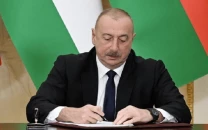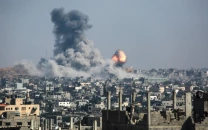Poppies bloom across Afghanistan as drought eases
The sight of a seemingly endless expanse of opium-producing flowers is common across rural Afghanistan

The sight of a seemingly endless expanse of opium-producing flowers is common across rural Afghanistan. PHOTO: AFP
The sight of a seemingly endless expanse of opium-producing flowers is common across rural Afghanistan, but this farm is in the centre of government-controlled Lashkar Gah city - the capital of Helmand province.
In a field AFP visited this month, workers were scoring grooves into the plants' bulbous seed pods from which the raw, milky-white opium oozes.
 In this photograph taken on April 13, 2019, Afghan farmers harvest opium sap from a poppy field in the Gereshk district of Helmand province. PHOTO: AFP
In this photograph taken on April 13, 2019, Afghan farmers harvest opium sap from a poppy field in the Gereshk district of Helmand province. PHOTO: AFP"We know it is harmful but we have no other way to earn money, this is the only income for us," labourer Mohammad Ghous told AFP.
Afghanistan is the world's top grower of opium, and the crop accounts for hundreds of thousands of jobs.
UN condemns Taliban's spring offensive in Afghanistan
Farmers grow poppies with impunity, as both Taliban and government officials often profit from the lucrative trade.
"The Taliban also don't care - they only need their share," said Gul Mohammad, a poppy farmer.
Afghan opium production took a hit last year as an intense drought dried fields and shrunk cultivation areas.
According to a UN survey, potential opium production dropped by 29 percent in 2018 compared to the previous year.
Still, production remained near record levels - and so far this year some farmers are seeing a rebound amid heavy rains that have poured over parts of Afghanistan in recent weeks.
 In this photograph taken on April 13, 2019, an Afghan farmer harvests opium sap from a poppy field in the Gereshk district of Helmand province. PHOTO: AFP
In this photograph taken on April 13, 2019, an Afghan farmer harvests opium sap from a poppy field in the Gereshk district of Helmand province. PHOTO: AFPConflict is also providing a surprising boon for the industry.
"(The) government was destroying poppy fields in previous years, but this year due to the ongoing war they couldn't," Mohammad said.
Most poppy production in Afghanistan is in the Taliban-controlled southern part.
The insurgents have long profited from poppies by taxing farmers and traffickers, and running their own drug-making factories that turn raw opium into morphine or heroin for export.
Hundreds of Afghan delegates to meet Taliban in Doha
Excess supply in recent years has led to falling prices, but a lack of alternative cash crops has left many Afghan farmers hooked on growing opium poppies.
"We have been cultivating poppies for twenty years," farmer Abdul Hadi said.
"It is less tiring, makes a lot of money and is less demanding than growing corn or wheat."
 In this photograph taken on April 13, 2019, an Afghan farmer shows a handful of opium sap harvested from a poppy field in the Gereshk district of Helmand province. PHOTO: AFP
In this photograph taken on April 13, 2019, an Afghan farmer shows a handful of opium sap harvested from a poppy field in the Gereshk district of Helmand province. PHOTO: AFPInternational donors have spent billions of dollars on counter-narcotics efforts in Afghanistan over the past decade, including efforts to encourage farmers to switch to other cash crops such as saffron.
But so far, efforts to move farmers away from their lucrative but dangerous poppies have met with little success.



















COMMENTS
Comments are moderated and generally will be posted if they are on-topic and not abusive.
For more information, please see our Comments FAQ